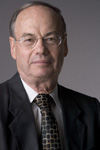|
Tuesday, Mar. 25
3:30 p.m.
DIRECTOR'S COFFEE BREAK - 2nd Flr X-Over
THERE WILL BE NO ACCELERATOR PHYSICS AND TECHNOLOGY SEMINAR TODAY
Wednesday, March 26
3:30 p.m.
DIRECTOR'S COFFEE BREAK - 2nd Flr X-Over
THERE WILL BE NO FERMILAB COLLOQUIUM THIS WEEK
Click here for NALCAL,
a weekly calendar with links to additional information. |
Tuesday, March 25
- Tomato bisque
- Lemon pepper club
- Beef with peppers
- Smart Cuisine: lasagna florentine
- Grilled chicken caesar wrap
- Assorted pizza slices
- Rio Grande taco salads
Wilson Hall Cafe Menu |
|
Wednesday, March 26
Dinner
- Roast pork calypso
- Fried plantain slices
- Black beans & rice
- Mango mousse w/coconut cookies
Thursday, March 27
Dinner
- Closed
Chez Leon Menu
Call x4598 to make your reservation. |
|
|
Furlough prompts Payroll Department adjustments
 |
| Ron Pahl, Payroll Department manager |
By now, everyone has felt the effects of furlough, including the Payroll Department. In addition to processing the rest of the laboratory's furloughs, the department members must take their own.
To deal with these circumstances, the Payroll Department will make the following changes to assure all employees receive their pay in a timely manner:
|
Register now for U.S. CMS Collaboration Meeting

Registration is open for the 2008 U.S. CMS Collaboration Meeting.
The clock is ticking to make your travel plans for the 2008 U.S. CMS Collaboration Meeting.
The University of Puerto Rico will host the annual meeting on May 2-3 in San Juan, Puerto Rico. To avoid late fees, all interested attendees should register online by April 1.
The upcoming meeting gives participants one final time to meet as a collaboration before the LHC turns on at CERN this summer. "This will be our last annual meeting before we start running at the LHC," said U.S. CMS collaboration chair Harvey Newman. "We will focus on the first days of running and the transition to first physics."
A number of speakers in key positions in CMS will present the status and plans of the experiment, including the project's spokesman Jim Virdee. Attendees will also break into discussion group to tackle such issues as coordinating CMS analysis around the world and the impact of new exchange rates on physicists' careers.
The meeting will take place in the San Juan Holiday Inn, just a short ride away from the airport. Rooms are still available for a special conference rate. "This will be a very exciting meeting with the anticipation of our first run," said workshop organizer Angel Lopez of the University of Puerto Rico. "San Juan will provide a unique backdrop."
-- Elizabeth Clements
|
CERN opens its doors to the world
From Interactions.org,
March 18, 2008
On 6 April 2008, CERN(1) will open its doors to the public, offering a unique chance to visit its newest and largest particle accelerator, the Large Hadron Collider (LHC), before it goes into operation later this year. This scientific instrument, the largest and most complex in the world, is installed in a 27km tunnel, 100 metres underground in the Swiss canton of Geneva and neighbouring France. CERN will open all access points around the ring for visits underground, to the tunnel and the experiment caverns. On the surface, a wide-ranging programme will be on offer, allowing people to learn about the physics for which this huge instrument is being installed, the technology underlying it, and applications in other fields.
In the LHC, particles such as protons or heavy ions will be accelerated to close to the speed of light in two tubes. At four intersection points the particles will collide at an energy never before reached in a particle accelerator to study new areas of physics that so far have not been accessible. Experiments at the LHC expect to be able to answer a number of fundamental questions, such as the origin of mass or the nature of the so-called "dark matter". However, since the LHC will explore a new energy range, there will also be unexpected results, resulting in new questions and new physics.
On the Open Day, many visitors to CERN will be able to descend and see the LHC and its big experiments, ALICE, ATLAS, CMS and LHCb in place in their underground caverns. However, since access to the underground areas is limited due to the capacity of the elevators and safety concerns, a range of activities is also planned on the surface where visitors will be able to learn about particle physics and talk to CERN engineers and physicists.
Read more
|
|
|
New records
 |
| Pier Oddone |
In my last column I wrote how, even without records, a week can be extraordinary. Those are the difficult weeks when we overcome a problem in some part of the accelerator complex with smarts, hard work and determination to collect significant luminosity despite the problem. Last week was extraordinary in a different way. All the accelerators worked smoothly, as often occurs well into a given run. The Tevatron appeared to have found a regular groove. Every fill went into the Tevatron docilely, and nearly all stayed there, behaving well, through the end of their cycles. Of course it is poetic license to call the beam injected into the Tevatron "docile" and a store "well behaved," as if it did not take the constant whip of the operators and the myriad control and feedback systems to keep the beast in line.
The record accumulated luminosity Friday-to-Friday was 49.9 inverse femtobarns--call it 50 among friends. We also established a new record in peak instantaneous luminosity of more than 3.1x1032 cm-2 sec-1, quite extraordinary numbers considering that we are reaching these luminosities with hard-to-produce antiprotons. We are also achieving these numbers with an old lithium lens, a spare with a lower gradient and hence a lower collecting efficiency for antiprotons than later versions of the lens. Of course, at this stage consistency of operations for maximum integrated luminosity is more important than achieving singular instantaneous records.
Physics results keep pouring out of both collaborations. Using the data from CDF and DZero, the UT fit collaboration has recently claimed a 3.7 sigma deviation from the Standard Model in Bs decays, a result that could be very important. The two collaborations are now re-analyzing and adding to the data to either prove or disprove this observation. Other physics channels show comparable levels of deviation indicating the potential for new physics. On the other hand, we expect a certain number of deviations when we look across such a broad set of channels. The doubling of the data from this point forward will either produce significant discoveries or conclude that these effects are likely statistical fluctuations. A key to get there will be the performance of the accelerators in the months to come. The new records augur well.
|
Welcome to the dark side
From Columbia Spectator,
March 24, 2008
No one took Fritz Zwicky seriously when he pointed out that the universe does not follow the rules we think it does. Working at Caltech in the 1930s, he studied galaxies, supernovae, and other recently discovered phenomena in the heavens. The idea that galaxies were clusters of stars, gas, and dust had only been confirmed in the 1920s, but by 1933, Zwicky was convinced that was not the whole story.
By all rights, galaxies should not exist at all. All the millions of stars, planets, and other bits of matter they contain still do not exert enough gravitational pull to hold them together-especially since they rotate outrageously quickly. Zwicky noticed that according to the law of gravity, rotating galaxies should be spinning out of control, shedding stars left and right. He hypothesized that galaxies were being held together by a mysterious substance we could not see, which he called dark matter.
At the time, the scientific community ignored his proposal. With the recently developed theories of relativity and quantum mechanics occupying their time, most physicists stayed focused on matter they could actually detect and study. Astronomers were busy coping with Edwin Hubble's discovery that the universe was expanding, which provided the first observational support for the Big Bang. The idea of dark matter was only seriously revisited 40 years later, when everybody began to realize Zwicky had it right all along. It turns out that there is over five times more dark matter than luminous matter in the universe.
Read more
|
|
Have a safe day!
New Computer Programming Courses
The first of five computer programming courses is offered on March 27 from 1-3:30 p.m.
"To Copy or Not to Copy: A Deeper Look at Values in C++," is aimed at programmers with C++ experience. The course deals in depth with issues related to copying values in C++ programs. Attendees will learn to identify and take advantage of opportunities for improved performance and will be prepared for related new techniques that will become available in the next C++ standard.
TRAIN credit will be awarded to participants. Course registration is free and now open. Future courses are at two-week intervals.
Excel 2003 Intermediate
An intermediate class on Excel 2003 is offered. Learn how to create templates, sort and filter data, import and export data,
analyze data and work with Excel on the Web. Learn more and enroll
FileMaker Pro 7 Level 2
Users needing to learn the more advanced features of FileMaker Pro and
techniques of integrated database system design. Learn more and enroll
Scottish Country Dance Tuesday
Scottish Country Dancing will meet Tuesday, March 25, at Kuhn Barn on the Fermilab site. Instruction begins at 7:30 p.m. and newcomers are always welcome. Most dances are fully taught and walked through, and you do not need to come with a partner. For more information, call (630) 840-8194 or (630) 584-0825 or folkdance@fnal.gov.
Additional Activities
|
|